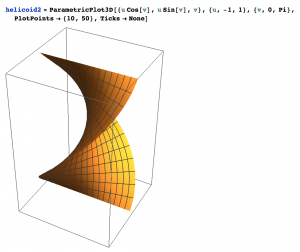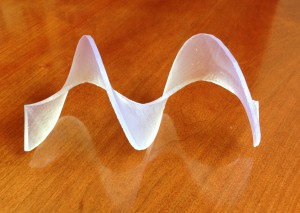In December, I was contacted by Professor Ricardo Nemirovsky from San Diego State University to design 3D printable surfaces for the Taping Shape* exhibit at the Rueben H. Fleet Science Center in San Diego, California. The exhibit runs from January 30 through June 12, 2016.
The exhibit contains a structure made out of packing tape with
three interconnected regions: a torus, a topological
equivalent to Schwarz P surface, and a pair-of-pants
surface with the legs twisted. The structure is large enough for visitors to walk and crawl through. There are three “work tables” (one for each region), with materials, suggested activities, poster displays, etc. The 3D printed models will be a part of the work table and displays.
Ricardo requested I make pair-of-pants surfaces with caps that can be joined together in different ways, Schwarz P surfaces that can be joined together, and also a frame that allows the Schwarz P surface to be created as a soap film spanning the frame. The challenge was on!
In the following blog posts, I’ll explain a bit about the math behind the surfaces, and how we figured out how to build and print them.
*The Taping shape exhibit is part of the InforMath project funded by the National Science Foundation (DRL-1323587). (The InforMath Project is a partnership between San Diego State University and several museums at the Balboa Park, including the Rueben H. Fleet Science Center .)


 After making them the correct size I optimized the polygons and extruded them by 0.20 cm (a process I can now do very quickly after all my practice with the quadratic surfaces). I then printed each of them on the liquid printer and had fantastic results!
After making them the correct size I optimized the polygons and extruded them by 0.20 cm (a process I can now do very quickly after all my practice with the quadratic surfaces). I then printed each of them on the liquid printer and had fantastic results!  The .STL and .form files for both of these helicoids can be found on
The .STL and .form files for both of these helicoids can be found on 

